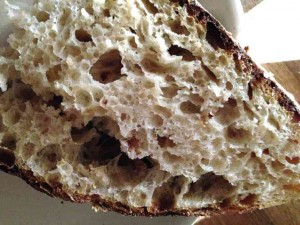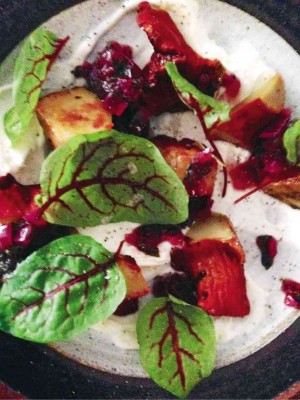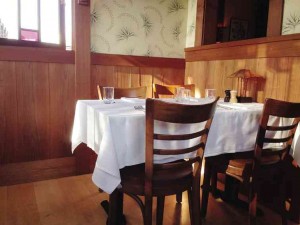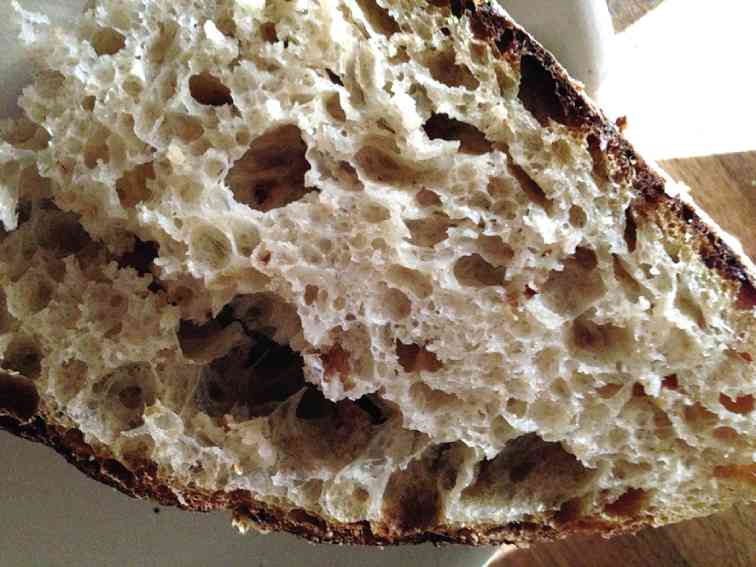
Upon a certain age, one’s thoughts turn naturally to themes of decomposition and ferment; we feel a closer kinship to yeast, bacteria and other microbes.
These days, among my circle, when we get a late-night call for an exchange of fluids, it’s more likely to be a swap of sourdough starter for kombucha.
The interest in fermentation has been a niche but growing corner of gastronomy for both home and restaurant cooks for some time now, and perhaps none has been so influential as Chad Robertson’s reinvention of San Francisco sourdough bread at his bakery, Tartine, which he has so far refused to franchise.
He has, however, written up the recipe in 40 pages’ worth of minutely explicit directions and photographs; if you’re not willing to buy the book, there’s an executive summary in the New York Times.
I tried making Tartine sourdough at home, and if you can wait two weeks from when you start to when you pull the finished loaf out of the oven, the results are astonishing and addictive. It’s much closer to the Parisian bakery Poîlane’s sourdough than traditional San Francisco sourdough, but it takes that dense, dry crumb and pushes it to its limits: very sour and wet, with a thick, crisp crust.
After having made the recipe so often at home, my family and I found ourselves in San Francisco with a few days to spare. We made our way out to the Mission district to Robertson’s second establishment, Bar Tartine.
It’s not quite a bakery, though not quite a proper restaurant, either. Everything about the place looked so hip that upon walking in, we felt at once garish and over-dressed.
There were people sporting handlebar moustaches, well-coiffed hair, tastefully faded jeans and designer sneakers.
But the bread was the star of the evening. We ate it with raw, fermented butter that was still swimming in buttermilk; it was dreamy, full of unexpected scents and ruminations. It was

just as good dipped in a salad of lobster mushrooms with a sharp, home-fermented yogurt sauce and tahini.
“How are the flavors?” asked the impossibly coiffed waiter. We nodded in approval, and moved on to the mains.
It was at this point that the meal somehow began to fall apart. My order of steak tartare came as a topping to a flatbread; I had had enough bread at that point. The strips of marinated meat (also in some kind of ferment) were at room temperature, which is an insipid temperature for beef to be at. Cold or very gently warmed would have been much nicer.
My wife had the chicken with beans and skordalia, which came as underflavored chicken breast chunks swimming in a sweaty liquid.
“How are the flavors?” popped up the server again, who seemed to have tweezed his beard in between courses. We nodded, with a little less enthusiasm this time.
Still worth a visit
Tartine is experimental, audacious and impossibly pretentious. Yet I would still recommend a visit, though perhaps not for a main meal. Go for the bread and the salads (which bear a strong resemblance to those of Ottolenghi), as well as for the drinks.
The beer and wine list is as exotic and fascinating, and even the soft drinks are not something you could make up. I was undecided between Shiso and verbena iced tea with honey and lemon and Rye kvass, while my wife had the Bergamot cola.
This restaurant’s food, drinks and handlebar moustaches are at the avant-garde of the earthy-food eating trope, the contemporary edge of a movement that started a few miles to the east over four decades ago by Alice Waters, at a restaurant called Chez Panisse.
Credit where it’s due
It’s amazing how many of the concepts that we take for granted these days came from an unassuming little restaurant that trained some of the most famous chefs today and whose ideas spread far and wide. Sourcing ingredients locally, using organic produce, working with farmers and suppliers, are things that are catching up here only recently. I’m not sure if they will ever be fully realized in this context.
It took 43 years for these stuff to make their mark among chefs around the world, spawning the Slow Food movement, the organic free-range marketing buzzwords, and the idea of a meal as a “moment” in place and time.
Chez Panisse today is still where it used to be, a quick drive out from central San Francisco, having been rebuilt after being nearly gutted by a fire in 2013. I had received plenty of warnings that many diners had been underwhelmed after finally making the pilgrimage to what has been hailed as the most important restaurant in America.
It isn’t dinner theater, like The Fat Duck or Thomas Keller, with smoke and mirrors and sleight-of-hand; it isn’t even dinner theater in the sense of a fancy Parisian restaurant. It looks and feels more like a place that one might find on Maginhawa St. in Quezon City.

We somehow managed to miss the entrance and entered through the back door, and had to make our way through one of the most breathtakingly beautiful kitchens: bowls and trays of gleaming produce; a wood-burning oven; and no one screaming or throwing cleavers.
We had an early evening meal at the café upstairs, looking out at the sun setting over the Berkeley landscape: salad, fresh ricotta ravioli, duck confit, a plum tart with almond ice cream.
The food, service and setting were flawless. But this is an old restaurant, one that has had time to mature and find its voice. What the voice says to young chefs is to go, find your way, and take the ideas that bore fruit there forward.
Because San Francisco is a kind of suburb of Metro Manila, many of the ideas have begun to make their way here, and there is now kefir and quinoa on supermarket shelves. I like these things, but they are the blooms and the buds.
What should take root here are principles about good food, eating well and making use of what is around us. Ideas are like microbes—they travel, grow and multiply and, in ideal conditions, they change the nature of the environment in which they live.
Bar Tartine is at 561 Valencia St., San Francisco, CA.
Chez Panisse is at 1517 Shattuck Ave., Berkeley, CA.









































